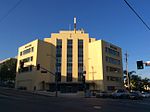Adams-Normandie, Los Angeles
Neighborhoods in Los AngelesSouth Los Angeles

The Adams-Normandie neighborhood of Los Angeles is a neighborhood within the South Los Angeles region of Los Angeles, California. It is notable within the city for its high density of population, its relatively low household income, its youthful population, its high average household size, the high percentage of its families headed by single parents and the high percentage of residents born outside the United States.
Excerpt from the Wikipedia article Adams-Normandie, Los Angeles (License: CC BY-SA 3.0, Authors, Images).Adams-Normandie, Los Angeles
South Normandie Avenue, Los Angeles Adams-Normandie
Geographical coordinates (GPS) Address Nearby Places Show on map
Geographical coordinates (GPS)
| Latitude | Longitude |
|---|---|
| N 34.032717 ° | E -118.300274 ° |
Address
Normandie & Adams
South Normandie Avenue
90089 Los Angeles, Adams-Normandie
California, United States
Open on Google Maps







